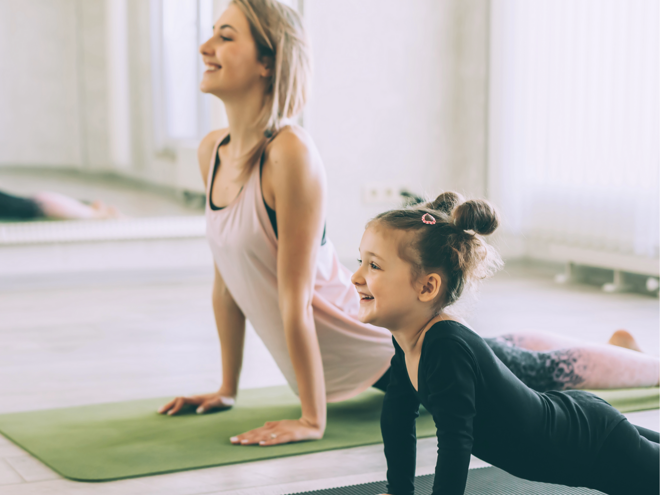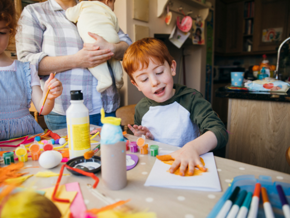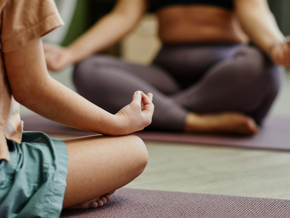
What is children’s yoga?
Yoga is a holistic practice that combines physical movement, breath control, and mindfulness to promote overall well-being. Adults often choose to practice yoga to enhance flexibility, build strength, reduce stress, and achieve a sense of inner peace. The meditative aspects of yoga allow individuals to gain a greater awareness of their bodies and minds.
Children’s yoga shares many of the same principles with adult yoga but is tailored to meet the unique needs and developmental stages of young learners. While adult yoga often emphasises longer pose holds and mindful reflection, children's yoga is more playful and fluid. It often incorporates imaginative themes, storytelling, and interactive elements that entertains young minds and keeps them interested. Pose holds are typically much shorter, allowing children to explore movement in a fun and dynamic way.
As parents and educators recognise the benefits of yoga for preschoolers, the popularity has grown. Today, children's yoga classes are commonly offered in various settings, including after-school care programs, day-care centres, and community organisations. These classes provide an opportunity for preschoolers to learn the fundamentals of yoga while developing important skills such as balance, coordination, and mindfulness, all in a supportive and enjoyable atmosphere.
When should I introduce yoga to my kids?
Introducing gentle, child-centred yoga can begin as early as toddlerhood. But around preschool age is when children are more developmentally equipped to focus and follow simple instructions, making it easier for them to engage in yoga practices. The playful nature of yoga for kids aligns perfectly with the curiosity and energy of preschoolers, and develops essential skills such as balance, coordination, and mindfulness.
While many parents may consider enrolling their little ones in classes led by registered instructors, children’s yoga doesn’t always need to be structured in this way. With the right timing, activities, and environment, parents can easily introduce yoga poses for preschoolers, at home. Create a calm and inviting space and choose age-appropriate poses. Incorporating fun themes, like animal yoga for preschoolers, can transform children’s yoga into an enjoyable bonding activity. Whether practiced weekly or even daily, these shared moments of yoga with preschoolers can improve communication and promote a sense of well-being for both parents and their little ones.
What are the benefits of doing yoga with preschoolers?
The benefits of yoga for preschoolers extends beyond a fun pastime and includes physical, mental, and emotional advantages. By practicing yoga together, you can support their overall development while creating cherished bonding moments. Some core benefits of doing yoga with preschoolers includes:
Emotional benefits of yoga for preschoolers
Practicing yoga at a young age can help build confidence and self-esteem. Through yoga, children learn to connect with their bodies and feelings, which encourages a sense of self-awareness. Activities such as regular breathwork help children learn to regulate emotions, and using a variety of poses helps them gain a sense of accomplishment, which builds their confidence.
Physical benefits of yoga for preschoolers
Yoga promotes physical development in preschoolers by enhancing flexibility, strength, and coordination. Practicing different poses that involve stretching and balancing help children develop their motor skills and body awareness. These physical activities not only contribute to overall health, but if enjoyed can set the foundation for a lifetime of active living.
Mental benefits of yoga for preschoolers
Yoga also offers mental health benefits, including improved focus and concentration. Through mindful breathing and guided movements, children learn to calm their minds and stay present in the moment. Activities such as simple meditation or visualisation exercises can help preschoolers develop their attention spans. For example, guiding them through a short story-style meditation allows them to practice listening and following along, enhancing their cognitive skills.
Social benefits of yoga for preschoolers
Participating in yoga with the whole family, or other kids can create a sense of community and improve social skills. Group yoga activities encourage teamwork and cooperation, as children learn to share space and take turns in poses.
How to do yoga at home with your preschooler
If your child is familiar with yoga at preschool or daycare, introducing them to yoga in the home environment can be quite different. The comfort of home allows for a more relaxed atmosphere, where you can explore yoga together in a way that suits your family's needs.
Preparing the home for a yoga session with your preschooler
- Choose a dedicated space: Find an area with enough room for you and your child to move freely, ensuring there are no hazards around.
- Natural light: If possible, select a space with natural light to create a warm and inviting atmosphere.
- Soft outdoor space: Consider practicing yoga outdoors on a soft surface, such as grass, to enhance the experience.
- Have supplies ready: Keep towels, water bottles, and healthy snacks on hand to stay comfortable and hydrated during your session.
- Remove distractions: Turn off screens and eliminate other distractions to help maintain focus and create a calming environment.
Breathing activities and yoga poses for preschoolers
Here are some fun animal yoga poses for preschoolers to enjoy at home that incorporates kid-friendly movements and breathing patterns to calm little minds:

What to watch out for when doing yoga with your kids
To truly capture the benefits of yoga for preschoolers it's important to prioritise fun and relaxation. While yoga can be a great way to bond and promote well-being, young children are still learning to understand their bodies and how to move. So effort and creativity should be promoted over perfecting poses or maintaining complete silence throughout a session.
Remain flexible when moving through your chosen yoga poses for preschoolers. If your child is restless or distracted, it’s perfectly okay to adjust the flow of the session or shorten the intended time. Allowing for spontaneous movement, giggles, and even chatter can make the experience way more fun. Just trying out a new activity, pose, or breathing exercise is a significant accomplishment in children’s yoga!
However, it’s important to acknowledge that your yoga sessions may not always be as relaxing as they were before you had children. Embrace the joyful chaos that comes with practicing yoga with preschoolers and remember that the connection you build through these shared moments is what truly matters.
Frequently asked questions about the benefits of yoga for preschoolers
Can 4 year olds do yoga?
Absolutely! Four-year-olds can definitely participate in yoga. Yoga for preschoolers is a fun and engaging activity that incorporates playful poses and imaginative themes that capture their attention. Even short sessions can provide great benefits, helping them develop flexibility, balance, and mindfulness.
How do you explain yoga to preschoolers?
When explaining yoga to preschoolers, keep it simple and relatable. You might say, "Yoga is like a fun game where we move our bodies and breathe deeply. We can pretend to be animals, stretch like a cat, or balance like a flamingo!" Using playful language and connecting yoga to their interests makes it easier for them to understand and relate.
What is the easiest yoga for kids?
The easiest yoga for kids includes simple poses that are fun and simple to achieve with limited balance and coordination. Animal yoga for preschoolers is often a hit, such as a Butterfly and Dog Poses, and Bunny Breathing. These yoga moves are easy to perform but also encourage creativity and imagination. Incorporating animal themes and storytelling can make the experience more enjoyable for young children.
What are 5 benefits of yoga for children?
The benefits of yoga for preschoolers includes improved physical flexibility and strength; enhanced focus and concentration; helps with emotional regulation; increases self-confidence; and offers opportunities for social interaction. By practicing yoga, children can learn to connect with their bodies and emotions that supports their well-being and overall development.
What EYLF outcome is yoga?
The Early Years Learning Framework (EYLF) is a valuable resource for early childhood educators in Australia, promoting a holistic approach to children's learning and development. Yoga aligns with several outcomes of the EYLF, particularly in relation to "Children have a strong sense of wellbeing." Engaging in yoga helps children develop physical skills, emotional resilience, and a sense of belonging, all of which contribute to their overall well-being and development in a holistic manner.
Can children with physical disabilities do yoga?
Yes, children with physical disabilities can participate in yoga! Adaptations can be made to ensure that yoga is accessible and enjoyable for all children, regardless of their abilities. Chair yoga, gentle stretches, and breathing exercises are all excellent options, allowing children to experience the benefits of yoga in a supportive and inclusive environment.
Sources:
- The Australian Children’s Education and Care Quality Authority Website. Accessed at ACECQA






